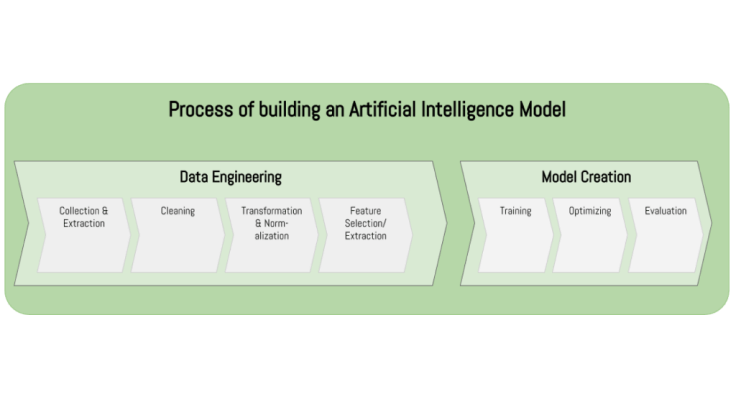In the previous chapters, we talked about how AI is affecting Marketing, how you can start changing your strategy towards more AI and data-driven approaches. In this chapter, we want to dive into the actual base of what AI models are built upon – your data. We’ll talk about how to get the right data and prepare it for the actual building of your own AI model in the future (see our blog article:The Benefits of AI in Marketing to learn why this is important).
It is well known that the availability of good data is essential in order to leverage the full potential of artificial intelligence. But what does that mean for your data and how the process of data preparation should look like; Did you make sure you have the right data available to be able to apply AI?
In this article, we want to share some insights into how AI actually works with data and what you need, as a marketer, to ensure you are able to apply artificial intelligence to your data.
5 simple steps to make your data ready for AI
1. Ensure data is stored.
All data should be saved at all times. Not just in your online CRM, but in all the tools you use. Especially metrics, such as KPI’s and their historical data.
2. Ensure data is available for you to export.
Make sure every online tool you use, allows you to get the data out/export it to run your own models with it if needed.
3. Avoid inconsistency.
Make sure that you don’t use overlapping tools or technologies. Only one CRM, only one web analytics software etc.
4. High data quality.
Ensuring high data quality on all levels will allow you to more easily build & run your AI models. This means, avoid double-tracking for instance or make sure your UTM-Codes are clean and easy to distinguish.
5. Historical data.
With only a few data points, it will not be possible to build good AI models for your business. So, you need to make sure that you have enough data and store it early on. The more history your KPIs have, the more sediment that can be read out of it. Make sure you backup your data periodically in order to have enough historical data.
As a next step, we want to go one level deeper and talk about the process of building and running an AI model with your Marketing data.
Data Preparation for your AI Marketing Model
Generally, we can say that, before being able to create an Artificial Intelligence Model, a lot of data preparation is needed – we will call it “Data Engineering” for now. Usually, one says that 80% of the effort of actually building an AI model goes into the extraction, preparation and normalization of the data. We created a graph showing you this process:

To make this easier to understand, we split the data preparation process into what we call “Data Engineering” (also called Data Preparation in literature) and “Model Creation”. In this chapter, we’ll mainly talk about Data Engineering and what is needed before actually building an Artificial Intelligence/Machine Learning Model.
Let’s give you an overview of the different process steps and how they can look like in Marketing:
Data Engineering
Usually, 80% of the time for building an AI Model is used for “Data Engineering”. This is especially so if you have heavy fragmented or unstructured data from various sources; this becomes an issue. In Marketing, most of our customers tend to have many different marketing tools and sources, which make these steps very important.
Collection & Extraction
First step – before working with any data, we need some data. Sounds easy, right?
Well, it actually isn’t that easy and can be very hard, complex and expensive. Let’s take an example of an often seen Martech stack of our customers:

Each of these tools have important data, for example, KPIs, reports you want to look at and have at your hand. Running Integrated Marketing Campaigns will touch on many of these channels and create important data in each of the tools. Collection & Extraction of data in Digital Marketing is actually harder than what one thinks of in the first place, because many providers do not offer a very easy and clean way of getting the data. We’ll jump into more detail in the next article on that subject. You can do this step manually, by exporting data from each provider, or using automated interfaces called “APIs” from each of the providers.
Cleaning
If you have all the data together – you can now start cleaning it. The cleaning is very important in order to be sure that you can use the data to train your model. For example, in this step, you’ll check if you have any missing data, some incorrect data and what to do about it. This step is, again, very important to do before you touch any AI Model.
Transformation & Normalization
In this step, you start looking at all the numbers which look the same or similar. This will make your AI model faster and better. As an example, maybe you have revenue numbers which are very high, but submissions on your landing page which are very low (numerically). In this step, you might consider normalizing them and therefore make it easier for the model to compare them. (I.e. see Mathematical functions, normalization).
Feature selection & Extraction
At the end of the Data Engineering, comes the Feature Selection. Now, you decide what data or we can also say “Column” is actually important for the problem you want to solve, and what data you can really use. If you have only 10 points of data for a certain column, this doesn’t really help and will prevent you from forming a good model.
Hope you liked this little deep dive into Data Engineering for AI in Marketing. In the next part of our blog, we’ll talk about the AI model creation (the 2nd part of the process).